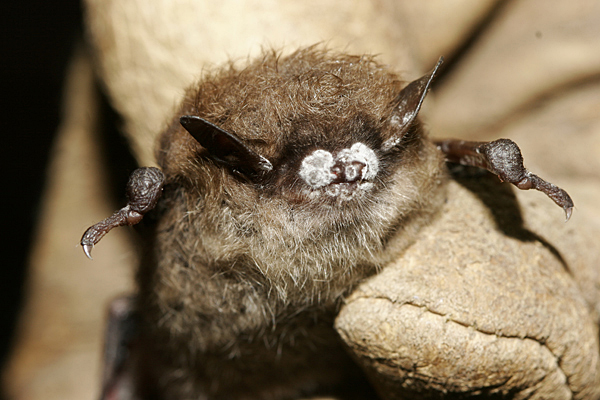
Bat decline
UD grads research white-nose syndrome in bats
1:40 p.m., Oct. 31, 2011--Erin Adams devotes “99 percent” of her work hours to bats -- in particular, to white-nose syndrome in bats -- as a research assistant in the Delaware Division of Fish and Wildlife. But her interest in these creatures of the night was sparked many years ago.
A 2007 graduate of the University of Delaware College of Agriculture and Natural Resources, Adams was required, as a wildlife conservation major, to take a course in mammalogy. She quickly discovered that her favorite taxonomic group didn’t win any popularity contests with her fellow classmates.
Research Stories
Chronic wounds
Prof. Heck's legacy
“Everyone loves the cuddly creatures or the big, attractive mammals – the polar bears and the wolves,” says Adams. “Me, I’ve always liked the underdog; I think that’s why I was drawn to bats.”
Bats are the only mammals capable of sustained flight; nonetheless, they don’t get a lot of respect from humans. Bats have long been associated with witchcraft, ghosts, death and darkness (hence their prominence in Halloween decorations). They’ve been called “birds of the devil” and, if you believe the novel Dracula, they can transform into vampires.
But Adams knows that only vampire bats drink blood (and even they don’t turn into vampires, last she checked). Instead, most bats are prodigious insect-eaters.
The little brown bat, found here in Delaware and the species most impacted by white-nose syndrome, can eat up to 1,200 mosquitoes an hour. Considering that West Nile virus, Eastern equine encephalitis and many other diseases are transmitted by mosquitoes, Adams would like to be able to say that the little brown bat population is on the upswing.
But the reality is just the opposite. Due to white-nose syndrome, little brown bats are dying in record numbers throughout the Northeast.
White-nose syndrome was first identified in 2006, when large numbers of dead bats were found in caves in New York. The fungus associated with the disease was found on bats in Delaware in April 2010 and has been seen as far south as Tennessee and north into Canada. It appears to be specific to bats and has not affected humans, pets or livestock.
Little brown bats appear to contract the fungus while hibernating, not during the summer breeding season in Delaware, according to Holly Niederriter, a wildlife biologist with the Division of Fish and Wildlife who leads the state’s research efforts on white-nose syndrome and who, like Adams, is a UD grad.
Little brown bats over-winter in caves. Since Delaware has only one small cave, most little browns likely migrate in the winter to caves in nearby parts of Maryland, New Jersey or Pennsylvania.
“We don’t know if the fungus can spread when the bats are together in their summer maternity colonies,” says Niederriter. “Right now our research is focused on gathering information through bat surveys. Some of this work involves catching and sampling the bats to assess their health – for example, unusually heavy scarring of the wings is indicative of disease.”
“And we use lots of volunteers to count bats at known colonies to see if populations are decreasing,” she says. “It’s going to take more research to see results; we don’t yet have answers.”
Niederriter and Adams understand the urgency of their task; they know that the little brown bat could be running out of time.
“Bat biologists predict that white-nose fungus could lead to total extinction of the little brown bat in northeastern U.S. within two decades,” says Niederriter.
Delaware is home to eight documented species and two other possible species. The most common species in the state are the big brown, tricolored and Eastern red. Although most of Delaware’s bats are likely migrants, many also over-winter here, finding shelter in tree cavities, under bark, in buildings and other cool spots.
Adams is responsible for recruiting volunteers to assist with counts and catches. “I get volunteers of all ages, from all walks of life,” she says. “I really enjoy the opportunity to connect with the public and see people get excited about bats the way I am.”
UD grad student Jenny Caldwell is one such volunteer. This past summer, she counted bats at a colony in Newark, once in early June, before the new season of babies (known as pups) was born, and again in late July when the juveniles were flying.
“It’s an important thing that the state is doing, trying to figure out what’s going on with white-nose syndrome,” says Caldwell. “I was happy to help with the count.”
To get involved
If you’d like to help monitor the state’s bat population during the 2012 Bat Count, call Erin Adams at 302-735-8669.
Article by Margo McDonough
Photo courtesy Ryan von Linden/New York Department of Environmental Conservation








